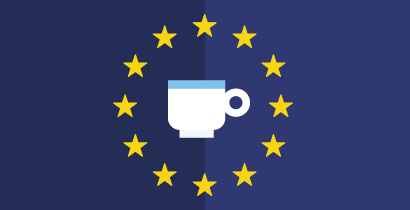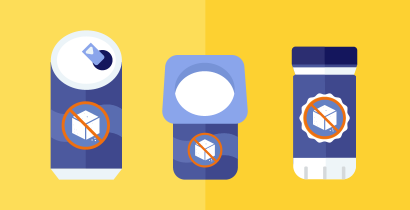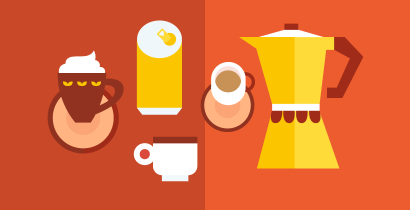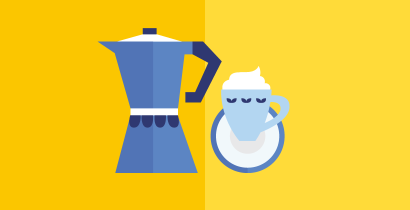Caffeine levels in different foods and drinks
Last Updated : 31 July 2024
We all love our morning cup of coffee, and for good reason – caffeine, that magical compound that takes away our sleepiness and makes us wide awake. But do you know how much caffeine is in your cup of coffee? And how many cups of coffee are safe to drink per day? This article explores which foods and drinks contain caffeine and how much caffeine they contain.
Which foods and drinks contain caffeine?
Caffeine is naturally found in the leaves, seeds, and fruits of many plants, including tea leaves, cocoa beans, coffee beans, guarana, and kola nuts. That means caffeine is present in coffee and coffee-flavoured foods (e.g., tiramisu, coffee-flavoured ice cream, and other coffee-flavoured snacks and sweets), as well as in tea (except rooibos and herbal teas) and chocolate and chocolate-flavoured foods and beverages. Caffeine is also added to some beverages (e.g., colas and energy drinks), supplements (e.g., sport and weight loss supplements), and medicines.1
How much caffeine is found in different foods and drinks?
The amount of caffeine found in food and beverages can vary depending on the manufacturing process, raw ingredients, and product composition. Processing and brewing time of coffee or teas also affect the caffeine level.
The presence of caffeine has to be clearly labelled in drinks containing more than 150 mg/L according to European legislation. However, this rule only applies to some soft drinks and energy drinks containing caffeine, not to tea, coffee, and their related products.2
Concentrations of caffeine that are found in common caffeine-containing food and beverages are listed below.
Coffee
Coffee is made from the roasted beans of the Coffea plant and the caffeine content can vary significantly among different types of coffee. A 200 ml cup of brewed coffee generally contains about 90 mg of caffeine, but this can vary depending on factors such as the type of coffee bean, brewing method, and serving size. As a rule of thumb, longer brewing times increase the caffeine concentration. A shot of espresso tends to contain a bit less caffeine than a standard cup of brewed coffee, with about 80 mg per 60 ml. Coffee drinks such as a cappuccino and a latte contain a similar caffeine content as they are typically based on one shot of espresso. Contrary to popular belief, decaf coffee may still retain small amounts of caffeine at about 4 mg per 200 ml cup. Coffee is the main source of caffeine intake for adults and the elderly in the EU, with the exception of the UK and Ireland where the main source is tea.1
Coffee-containing foods such as tiramisu, coffee-flavoured ice cream, and other coffee-flavoured snacks and sweets may also contain small amounts caffeine. The amount of caffeine in these foods depends upon the amount of coffee beans used in the recipe.
Tea
Tea is made from the leaves of the Camellia sinensis plant and the caffeine content in various types of tea can vary. A standard 250 ml cup of black tea typically contains around 28 mg of caffeine. Green tea has a slightly lower caffeine content of about 19 mg for the same serving size.1 As with coffee, factors like brewing time can influence the final caffeine content, as does how fine or coarse the tea leaves are ground and the temperature of the water which affects how much caffeine is released by the leaves.3 For those looking to avoid caffeine altogether, rooibos or herbal teas (e.g., chamomile, peppermint, ginger) can be a good option as they are not extracts from tea leaves and thus contain no caffeine.
Energy drinks
Energy drinks are carbonated drinks with added caffeine. They are often high in sugar, except for the no-added sugar varieties. Energy drinks typically contain 80 mg of caffeine per 250 ml serving, although the caffeine content can vary from brand to brand.1 Since the caffeine concentration of energy drinks is often more than 150 mg/L, the label must state the exact caffeine content (according to EU regulations). This is preceded by the following text: ‘High caffeine content. Not recommended for children or pregnant or breast-feeding women.’2
Cola
Cola is made from a combination of carbonated water, sweeteners, flavourings, and caffeine, and its caffeine content can vary across different brands and formulations. A standard 355 ml can serving of cola typically contain around 37 mg of caffeine.1 The consumption of sugar-rich soft drinks like cola have been directly linked to overweight and obesity, especially in children and adolescents, hence, the majority of national healthy eating guides recommend us to limit the consumption of sugar-rich foods and beverages.4
Chocolate
Chocolate is made from cacao beans which naturally contain caffeine. This means that all chocolate and foods flavoured with chocolate contain some caffeine. However, overall, people get less caffeine through these products than through coffee and tea and therefore they contribute also less to one’s total intake of caffeine. The amount of caffeine in chocolate depends on the percentage of cocoa it contains. Dark chocolate contains more caffeine than milk chocolate due to its higher cocoa content. A serving (14 g or 2 squares) of dark chocolate has approximately 7 mg of caffeine, while a similar serving of milk chocolate has approximately 2 mg of caffeine. Chocolate-flavoured foods and drinks, such as chocolate-flavoured ice cream, snacks, or beverages, may also contain small amounts of caffeine, depending on the recipe. Chocolate milk generally contains about 34 mg of caffeine per 200 ml serving.1
Supplements
In certain sport or weight loss or sports supplements caffeine may be added.1 The amount of caffeine in supplements has to be listed on the label. However, EFSA concludes that a cause-and-effect relationship between caffeine and an increased energy expenditure leading to a reduction in body weight is not established. EFSA also did not establish a cause-and-effect relationship between caffeine and improved physical performance during short-term high-intensity exercise or caffeine and increased endurance performance.5
Table 1 – Caffeine levels in different foods and drinks.1
|
Food or beverage |
Average amount of caffeine in mg/100ml or mg/100g (range) |
Serving size |
Caffeine per serving size (mg) |
|
Coffee |
|||
|
Coffee, filtered |
45 |
200 ml |
90 |
|
Coffee, instant |
45 |
200 ml |
90 |
|
Espresso coffee |
134 |
60 ml |
80 |
|
Coffee, decaffeinated |
2 |
200 ml |
4 |
|
Teas |
|||
|
Black tea |
22 |
250 ml |
55 |
|
Green tea |
15 |
250 ml |
38 |
|
Tea, unspecified |
17 |
250 ml |
43 |
|
Tea, decaffeinated |
3 |
250 ml |
8 |
|
Colas |
|||
|
Cola |
11 |
355 ml |
37 |
|
Energy drinks |
|||
|
Energy drink |
32 |
250 ml |
80 |
|
Chocolates |
|||
|
Chocolate milk, based on cocoa powder |
17 |
200 ml |
34 |
|
Dark chocolate |
53 |
14 g (2 squares) |
7 |
|
Milk chocolate |
17 |
14 g (2 squares) |
2 |
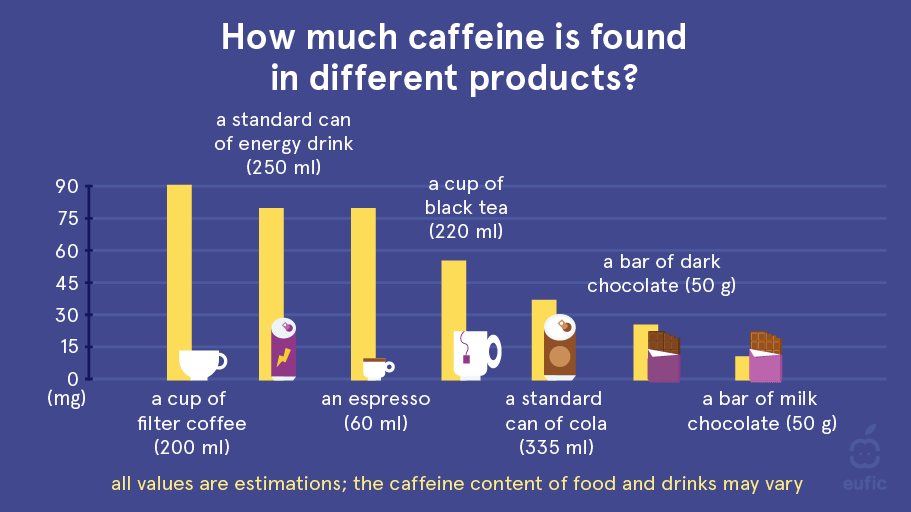
How much caffeine is too much ?
In 2015, the European Food Safety Authority (EFSA) has concluded that up to 400 mg of caffeine a day is safe for most adults. Single doses of caffeine of up to 200 mg also do not raise any safety concerns.1
400 mg of caffeine a day is equal to about:
• 7 cups of black tea (250 ml per cup, containing 55 mg of caffeine)
• 4 cups of filter coffee (200 ml per cup, containing 90 mg of caffeine)
• 5 espressos (60 ml per espresso, containing 80 mg of caffeine)
• 5 cans of energy drink (250 ml per can, containing 80 mg of caffeine)
• 10 cans of cola (355 ml per can, containing 37 mg of caffeine)
Pregnant or breastfeeding women are advised to limit their use of caffeine to 200 mg per day. This is equivalent to 2 cups of filter coffee or 3 ½ cups of tea. For children and adolescents, EFSA has proposed a safety level of 3 mg/kg body weight. For example, for a child weighing 30 kg, single doses of up to 90 mg caffeine would not give rise to safety concerns.
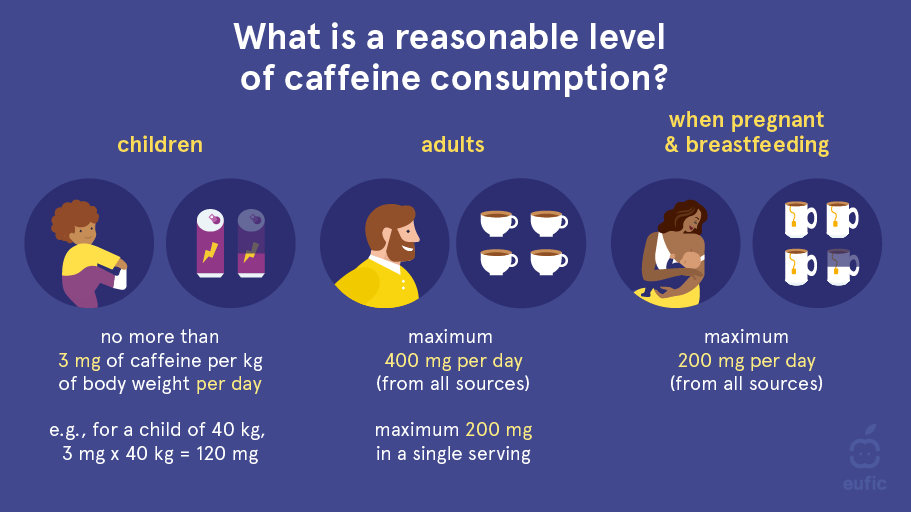
Summary
Caffeine is naturally present in coffee, tea, chocolate, and certain plants, while it may also be added to energy drinks, colas, and certain sports and weight loss supplements. Out of common caffeine-containing foods and beverages, coffee typically contains the highest amount of caffeine per serving at about 90 mg of caffeine per 200 ml serving. As such, coffee is the main source of caffeine intake for adults and the elderly in Europe, with the exception of the UK and Ireland where the main source is tea. EFSA concluded that caffeine consumption up to 400 mg per day and single doses of up to 200 mg of caffeine are safe for healthy adults.
References
- EFSA Panel on Dietetic Products, Nutrition and Allergies (NDA). (2015). Scientific Opinion on the safety of caffeine. EFSA Journal, 13(5), 4102.
- EUR-Lex. (2011). Regulation (EU) No 1169/2011 of the European Parliament and of the Council of 25 October 2011 on the provision of food information to consumers.
- Astill, C., Birch, M. R., Dacombe, C., Humphrey, P. G., & Martin, P. T. (2001). Factors affecting the caffeine and polyphenol contents of black and green tea infusions. Journal of agricultural and food chemistry, 49(11), 5340-5347.
- Luger M. et al. (2017). Sugar-sweetened beverages and weight gain in children and adults: A systematic review from 2013 to 2015 and a comparison with previous studies. Obesity Facts 10:674-693.
- 5. EFSA Panel on Dietetic Products, Nutrition and Allergies (NDA). (2011). Scientific Opinion on the substantiation of health claims related to caffeine and increased fat oxidation leading to a reduction in body fat mass (ID 735, 1484), increased energy ex
